Comprehensive Business Strategy Analysis of BHP Billiton in Australia
VerifiedAdded on 2020/04/01
|14
|3491
|486
Report
AI Summary
This report provides a comprehensive analysis of BHP Billiton's business strategy in the Australian market. It begins with an executive summary outlining the company's diversified commodities, global presence, and contribution to the Australian economy, including its social initiatives and transparency. The report then delves into BHP Billiton's competitive advantages, such as its strong business history, high profitability, leadership, diversity and inclusion programs, and transparency. It also discusses trends in the Australian steel manufacturing industry, analyzing its decline and BHP Billiton's role. The current business strategy is examined, including national and international strategies, such as acquisitions and cost leadership. An internal analysis using McKinsey's 7S framework assesses the management talent, resources, and capabilities. External analysis includes PESTLE and Porter's 5 Forces analyses. The report concludes by summarizing the key findings and providing a detailed overview of BHP Billiton's strategic position.
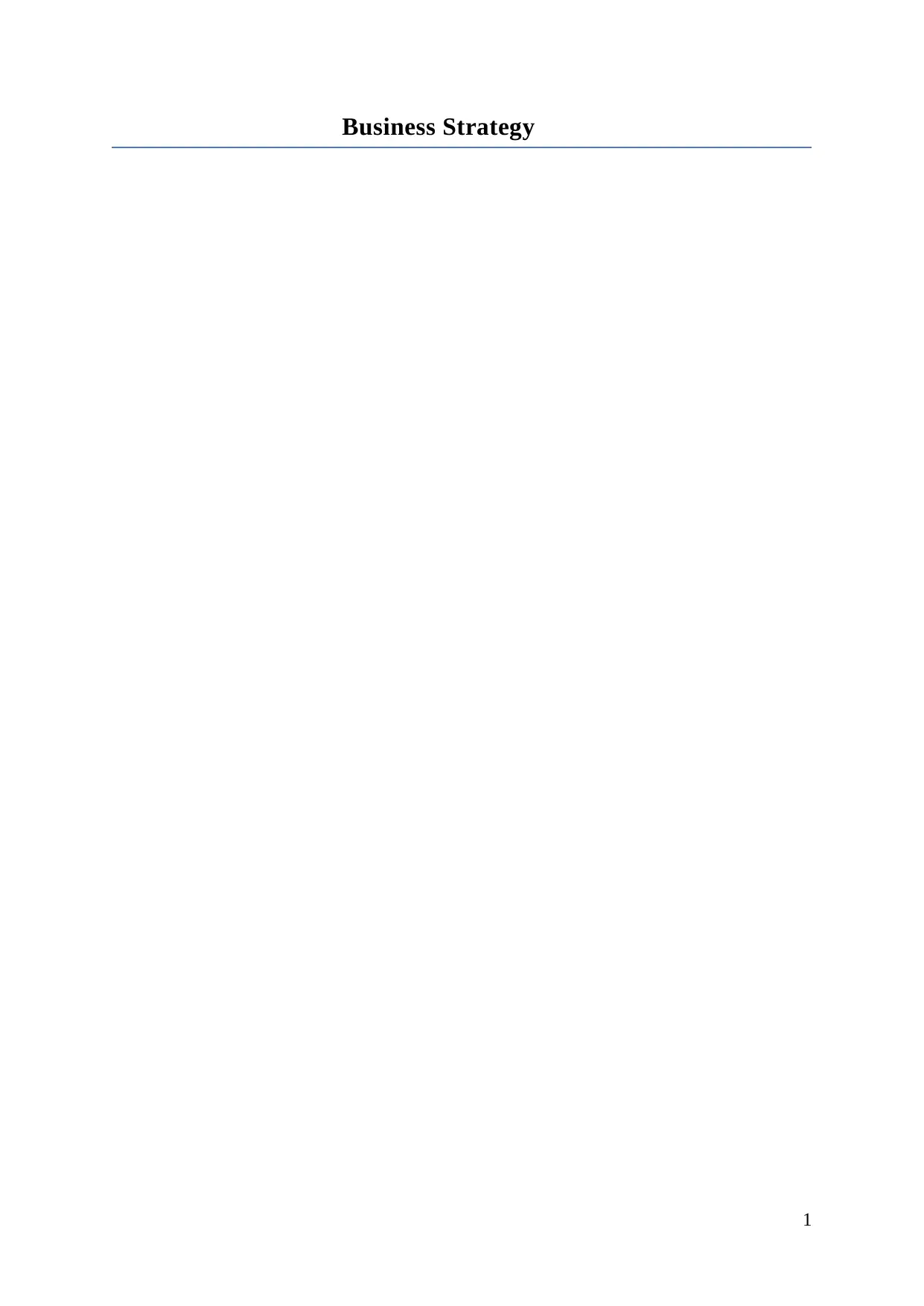
Business Strategy
1
1
Paraphrase This Document
Need a fresh take? Get an instant paraphrase of this document with our AI Paraphraser
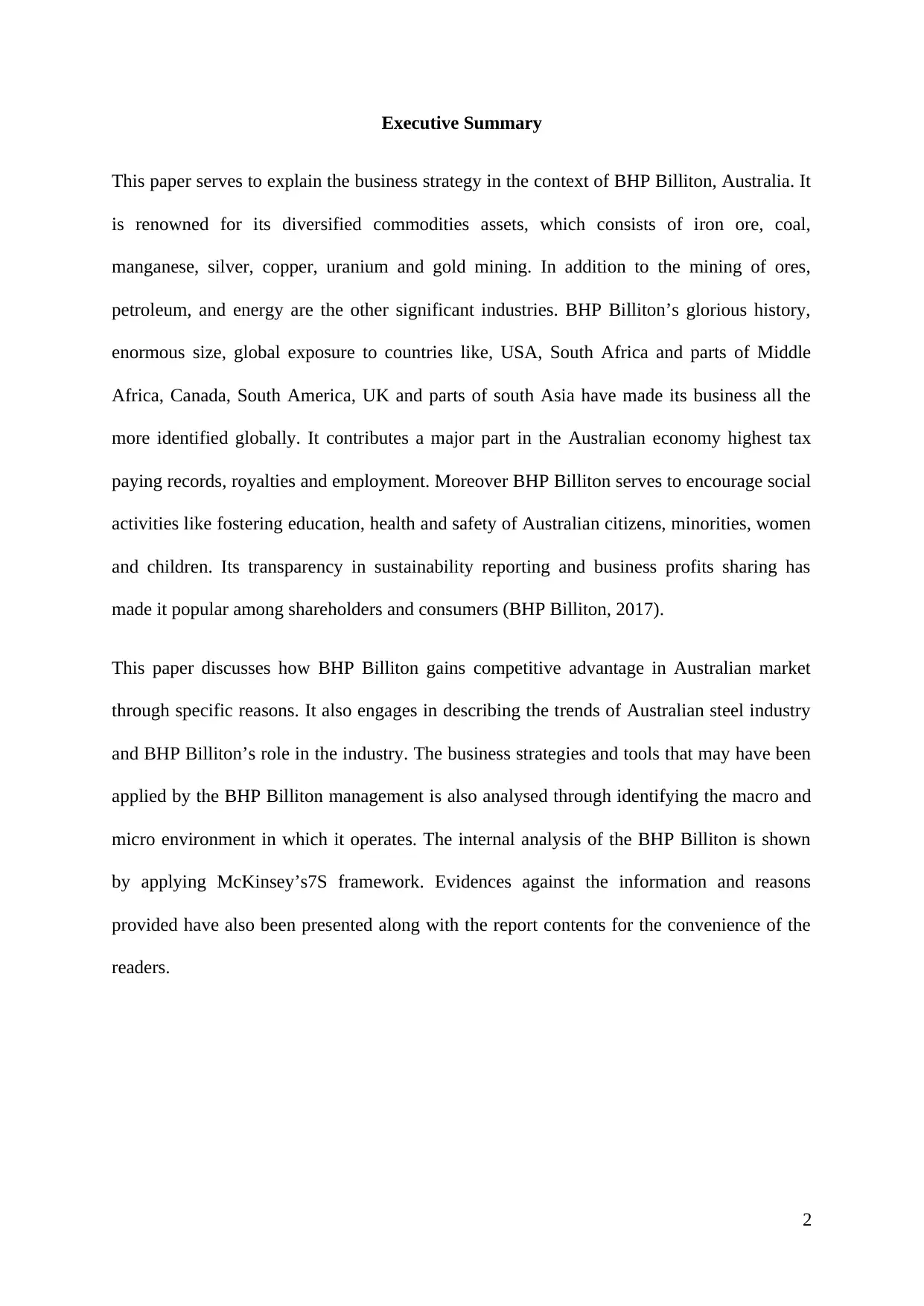
Executive Summary
This paper serves to explain the business strategy in the context of BHP Billiton, Australia. It
is renowned for its diversified commodities assets, which consists of iron ore, coal,
manganese, silver, copper, uranium and gold mining. In addition to the mining of ores,
petroleum, and energy are the other significant industries. BHP Billiton’s glorious history,
enormous size, global exposure to countries like, USA, South Africa and parts of Middle
Africa, Canada, South America, UK and parts of south Asia have made its business all the
more identified globally. It contributes a major part in the Australian economy highest tax
paying records, royalties and employment. Moreover BHP Billiton serves to encourage social
activities like fostering education, health and safety of Australian citizens, minorities, women
and children. Its transparency in sustainability reporting and business profits sharing has
made it popular among shareholders and consumers (BHP Billiton, 2017).
This paper discusses how BHP Billiton gains competitive advantage in Australian market
through specific reasons. It also engages in describing the trends of Australian steel industry
and BHP Billiton’s role in the industry. The business strategies and tools that may have been
applied by the BHP Billiton management is also analysed through identifying the macro and
micro environment in which it operates. The internal analysis of the BHP Billiton is shown
by applying McKinsey’s7S framework. Evidences against the information and reasons
provided have also been presented along with the report contents for the convenience of the
readers.
2
This paper serves to explain the business strategy in the context of BHP Billiton, Australia. It
is renowned for its diversified commodities assets, which consists of iron ore, coal,
manganese, silver, copper, uranium and gold mining. In addition to the mining of ores,
petroleum, and energy are the other significant industries. BHP Billiton’s glorious history,
enormous size, global exposure to countries like, USA, South Africa and parts of Middle
Africa, Canada, South America, UK and parts of south Asia have made its business all the
more identified globally. It contributes a major part in the Australian economy highest tax
paying records, royalties and employment. Moreover BHP Billiton serves to encourage social
activities like fostering education, health and safety of Australian citizens, minorities, women
and children. Its transparency in sustainability reporting and business profits sharing has
made it popular among shareholders and consumers (BHP Billiton, 2017).
This paper discusses how BHP Billiton gains competitive advantage in Australian market
through specific reasons. It also engages in describing the trends of Australian steel industry
and BHP Billiton’s role in the industry. The business strategies and tools that may have been
applied by the BHP Billiton management is also analysed through identifying the macro and
micro environment in which it operates. The internal analysis of the BHP Billiton is shown
by applying McKinsey’s7S framework. Evidences against the information and reasons
provided have also been presented along with the report contents for the convenience of the
readers.
2

Table of Contents
Introduction................................................................................................................................4
Discuss BHP Billiton’s competitive advantage?........................................................................4
Discuss some of the trends in the Australian steel manufacturing industry:.............................5
Discuss the current business strategy of BHP Billiton in Australia:..........................................5
Internal Analysis of BHP Billiton (Management talent; Resources & Capabilities).................6
Management Talent:...............................................................................................................6
Resources:..............................................................................................................................7
Capabilities:............................................................................................................................8
External Analysis (Macro and Micro)........................................................................................9
Pestle Analysis (Macro):........................................................................................................9
Porter’s 5Forces analysis (Micro):.......................................................................................10
Conclusion................................................................................................................................11
References................................................................................................................................13
3
Introduction................................................................................................................................4
Discuss BHP Billiton’s competitive advantage?........................................................................4
Discuss some of the trends in the Australian steel manufacturing industry:.............................5
Discuss the current business strategy of BHP Billiton in Australia:..........................................5
Internal Analysis of BHP Billiton (Management talent; Resources & Capabilities).................6
Management Talent:...............................................................................................................6
Resources:..............................................................................................................................7
Capabilities:............................................................................................................................8
External Analysis (Macro and Micro)........................................................................................9
Pestle Analysis (Macro):........................................................................................................9
Porter’s 5Forces analysis (Micro):.......................................................................................10
Conclusion................................................................................................................................11
References................................................................................................................................13
3
⊘ This is a preview!⊘
Do you want full access?
Subscribe today to unlock all pages.

Trusted by 1+ million students worldwide
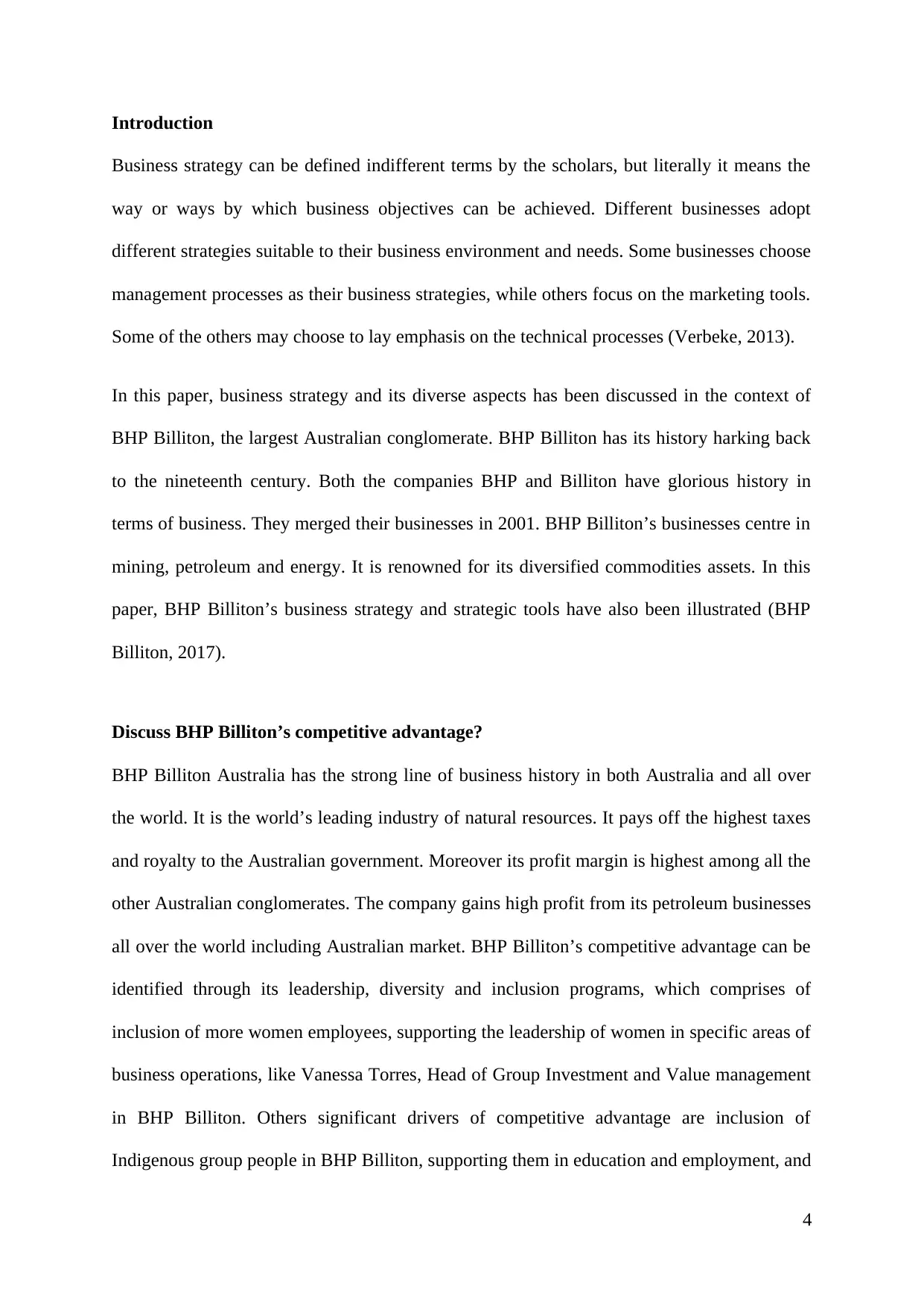
Introduction
Business strategy can be defined indifferent terms by the scholars, but literally it means the
way or ways by which business objectives can be achieved. Different businesses adopt
different strategies suitable to their business environment and needs. Some businesses choose
management processes as their business strategies, while others focus on the marketing tools.
Some of the others may choose to lay emphasis on the technical processes (Verbeke, 2013).
In this paper, business strategy and its diverse aspects has been discussed in the context of
BHP Billiton, the largest Australian conglomerate. BHP Billiton has its history harking back
to the nineteenth century. Both the companies BHP and Billiton have glorious history in
terms of business. They merged their businesses in 2001. BHP Billiton’s businesses centre in
mining, petroleum and energy. It is renowned for its diversified commodities assets. In this
paper, BHP Billiton’s business strategy and strategic tools have also been illustrated (BHP
Billiton, 2017).
Discuss BHP Billiton’s competitive advantage?
BHP Billiton Australia has the strong line of business history in both Australia and all over
the world. It is the world’s leading industry of natural resources. It pays off the highest taxes
and royalty to the Australian government. Moreover its profit margin is highest among all the
other Australian conglomerates. The company gains high profit from its petroleum businesses
all over the world including Australian market. BHP Billiton’s competitive advantage can be
identified through its leadership, diversity and inclusion programs, which comprises of
inclusion of more women employees, supporting the leadership of women in specific areas of
business operations, like Vanessa Torres, Head of Group Investment and Value management
in BHP Billiton. Others significant drivers of competitive advantage are inclusion of
Indigenous group people in BHP Billiton, supporting them in education and employment, and
4
Business strategy can be defined indifferent terms by the scholars, but literally it means the
way or ways by which business objectives can be achieved. Different businesses adopt
different strategies suitable to their business environment and needs. Some businesses choose
management processes as their business strategies, while others focus on the marketing tools.
Some of the others may choose to lay emphasis on the technical processes (Verbeke, 2013).
In this paper, business strategy and its diverse aspects has been discussed in the context of
BHP Billiton, the largest Australian conglomerate. BHP Billiton has its history harking back
to the nineteenth century. Both the companies BHP and Billiton have glorious history in
terms of business. They merged their businesses in 2001. BHP Billiton’s businesses centre in
mining, petroleum and energy. It is renowned for its diversified commodities assets. In this
paper, BHP Billiton’s business strategy and strategic tools have also been illustrated (BHP
Billiton, 2017).
Discuss BHP Billiton’s competitive advantage?
BHP Billiton Australia has the strong line of business history in both Australia and all over
the world. It is the world’s leading industry of natural resources. It pays off the highest taxes
and royalty to the Australian government. Moreover its profit margin is highest among all the
other Australian conglomerates. The company gains high profit from its petroleum businesses
all over the world including Australian market. BHP Billiton’s competitive advantage can be
identified through its leadership, diversity and inclusion programs, which comprises of
inclusion of more women employees, supporting the leadership of women in specific areas of
business operations, like Vanessa Torres, Head of Group Investment and Value management
in BHP Billiton. Others significant drivers of competitive advantage are inclusion of
Indigenous group people in BHP Billiton, supporting them in education and employment, and
4
Paraphrase This Document
Need a fresh take? Get an instant paraphrase of this document with our AI Paraphraser
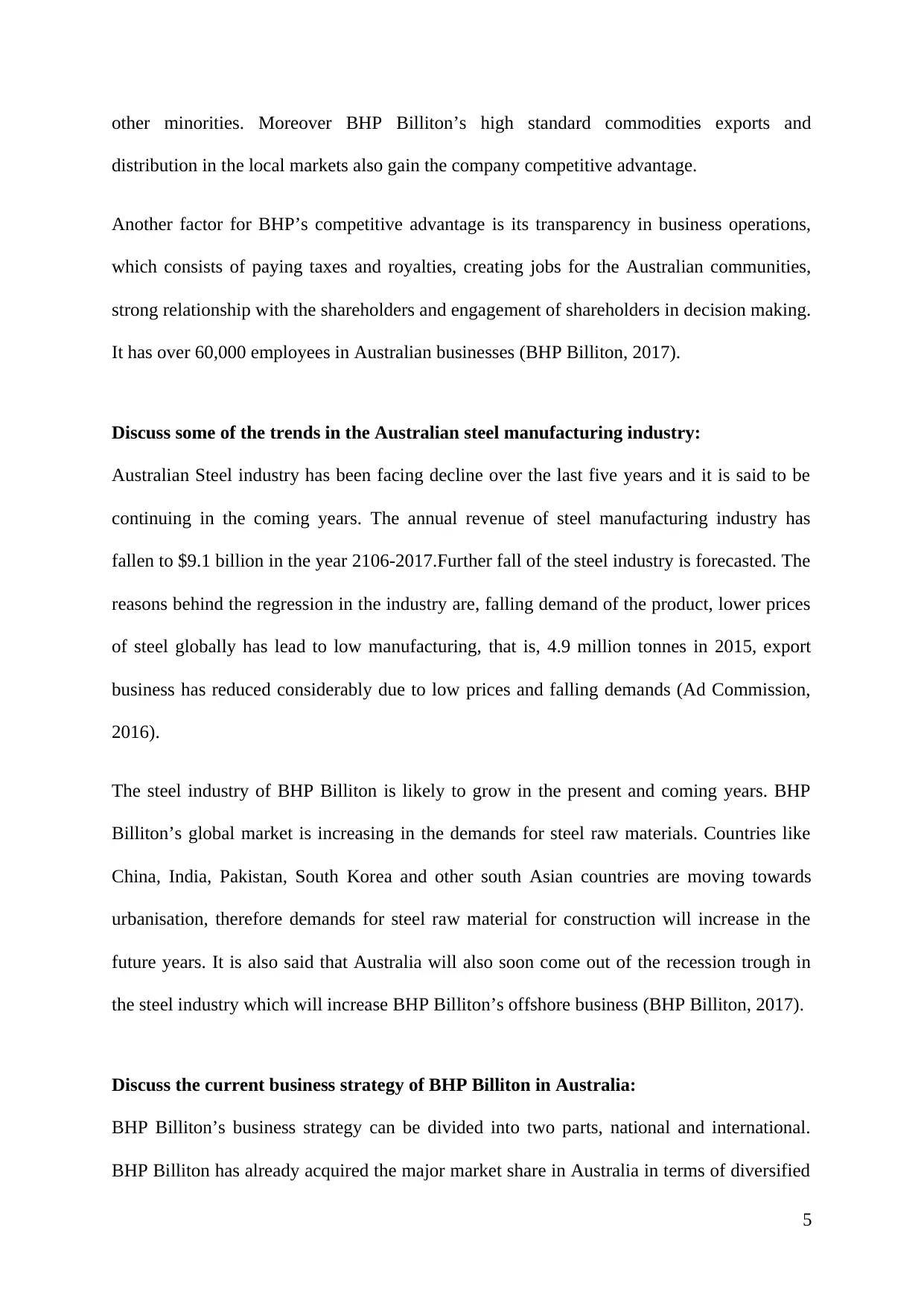
other minorities. Moreover BHP Billiton’s high standard commodities exports and
distribution in the local markets also gain the company competitive advantage.
Another factor for BHP’s competitive advantage is its transparency in business operations,
which consists of paying taxes and royalties, creating jobs for the Australian communities,
strong relationship with the shareholders and engagement of shareholders in decision making.
It has over 60,000 employees in Australian businesses (BHP Billiton, 2017).
Discuss some of the trends in the Australian steel manufacturing industry:
Australian Steel industry has been facing decline over the last five years and it is said to be
continuing in the coming years. The annual revenue of steel manufacturing industry has
fallen to $9.1 billion in the year 2106-2017.Further fall of the steel industry is forecasted. The
reasons behind the regression in the industry are, falling demand of the product, lower prices
of steel globally has lead to low manufacturing, that is, 4.9 million tonnes in 2015, export
business has reduced considerably due to low prices and falling demands (Ad Commission,
2016).
The steel industry of BHP Billiton is likely to grow in the present and coming years. BHP
Billiton’s global market is increasing in the demands for steel raw materials. Countries like
China, India, Pakistan, South Korea and other south Asian countries are moving towards
urbanisation, therefore demands for steel raw material for construction will increase in the
future years. It is also said that Australia will also soon come out of the recession trough in
the steel industry which will increase BHP Billiton’s offshore business (BHP Billiton, 2017).
Discuss the current business strategy of BHP Billiton in Australia:
BHP Billiton’s business strategy can be divided into two parts, national and international.
BHP Billiton has already acquired the major market share in Australia in terms of diversified
5
distribution in the local markets also gain the company competitive advantage.
Another factor for BHP’s competitive advantage is its transparency in business operations,
which consists of paying taxes and royalties, creating jobs for the Australian communities,
strong relationship with the shareholders and engagement of shareholders in decision making.
It has over 60,000 employees in Australian businesses (BHP Billiton, 2017).
Discuss some of the trends in the Australian steel manufacturing industry:
Australian Steel industry has been facing decline over the last five years and it is said to be
continuing in the coming years. The annual revenue of steel manufacturing industry has
fallen to $9.1 billion in the year 2106-2017.Further fall of the steel industry is forecasted. The
reasons behind the regression in the industry are, falling demand of the product, lower prices
of steel globally has lead to low manufacturing, that is, 4.9 million tonnes in 2015, export
business has reduced considerably due to low prices and falling demands (Ad Commission,
2016).
The steel industry of BHP Billiton is likely to grow in the present and coming years. BHP
Billiton’s global market is increasing in the demands for steel raw materials. Countries like
China, India, Pakistan, South Korea and other south Asian countries are moving towards
urbanisation, therefore demands for steel raw material for construction will increase in the
future years. It is also said that Australia will also soon come out of the recession trough in
the steel industry which will increase BHP Billiton’s offshore business (BHP Billiton, 2017).
Discuss the current business strategy of BHP Billiton in Australia:
BHP Billiton’s business strategy can be divided into two parts, national and international.
BHP Billiton has already acquired the major market share in Australia in terms of diversified
5
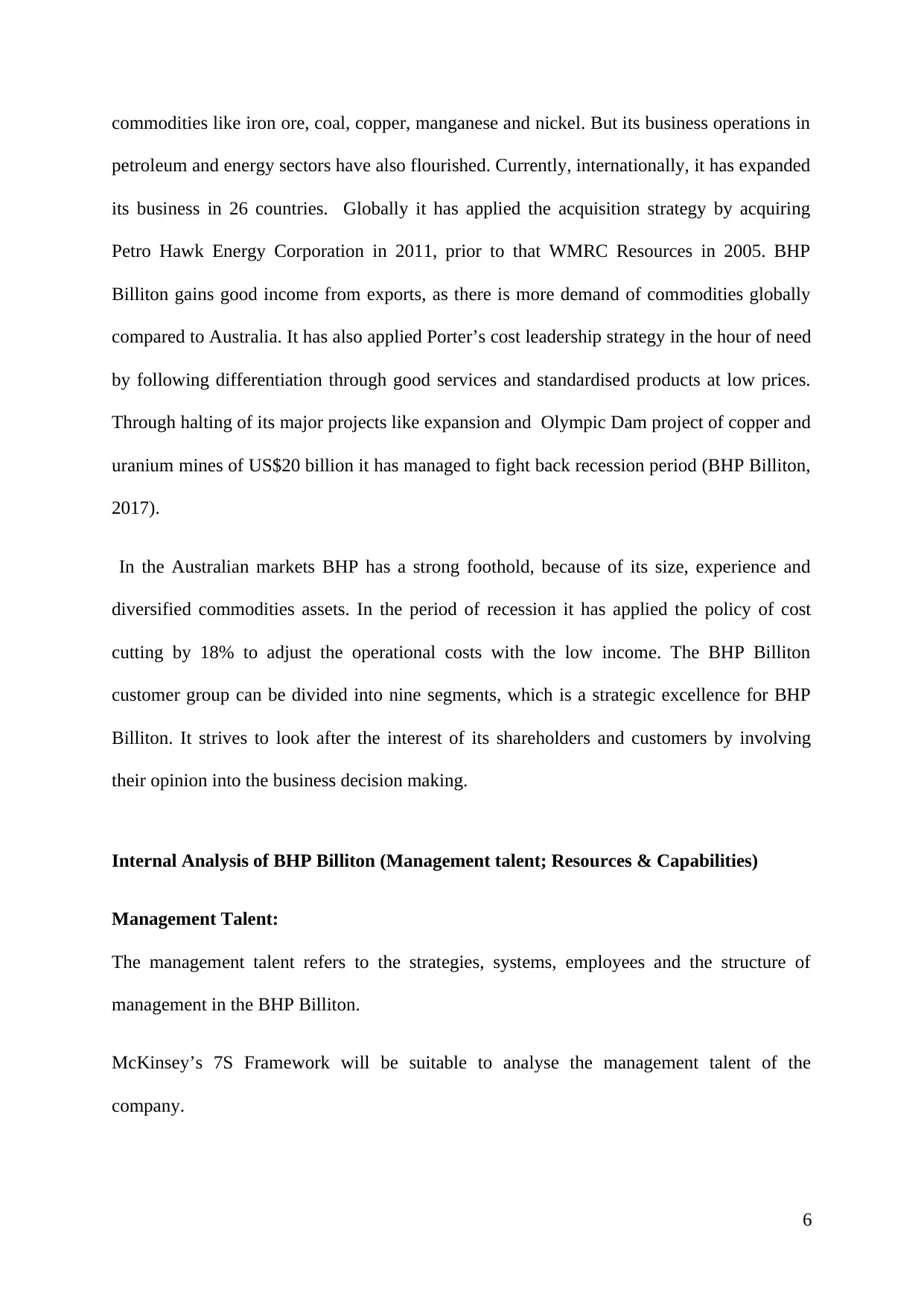
commodities like iron ore, coal, copper, manganese and nickel. But its business operations in
petroleum and energy sectors have also flourished. Currently, internationally, it has expanded
its business in 26 countries. Globally it has applied the acquisition strategy by acquiring
Petro Hawk Energy Corporation in 2011, prior to that WMRC Resources in 2005. BHP
Billiton gains good income from exports, as there is more demand of commodities globally
compared to Australia. It has also applied Porter’s cost leadership strategy in the hour of need
by following differentiation through good services and standardised products at low prices.
Through halting of its major projects like expansion and Olympic Dam project of copper and
uranium mines of US$20 billion it has managed to fight back recession period (BHP Billiton,
2017).
In the Australian markets BHP has a strong foothold, because of its size, experience and
diversified commodities assets. In the period of recession it has applied the policy of cost
cutting by 18% to adjust the operational costs with the low income. The BHP Billiton
customer group can be divided into nine segments, which is a strategic excellence for BHP
Billiton. It strives to look after the interest of its shareholders and customers by involving
their opinion into the business decision making.
Internal Analysis of BHP Billiton (Management talent; Resources & Capabilities)
Management Talent:
The management talent refers to the strategies, systems, employees and the structure of
management in the BHP Billiton.
McKinsey’s 7S Framework will be suitable to analyse the management talent of the
company.
6
petroleum and energy sectors have also flourished. Currently, internationally, it has expanded
its business in 26 countries. Globally it has applied the acquisition strategy by acquiring
Petro Hawk Energy Corporation in 2011, prior to that WMRC Resources in 2005. BHP
Billiton gains good income from exports, as there is more demand of commodities globally
compared to Australia. It has also applied Porter’s cost leadership strategy in the hour of need
by following differentiation through good services and standardised products at low prices.
Through halting of its major projects like expansion and Olympic Dam project of copper and
uranium mines of US$20 billion it has managed to fight back recession period (BHP Billiton,
2017).
In the Australian markets BHP has a strong foothold, because of its size, experience and
diversified commodities assets. In the period of recession it has applied the policy of cost
cutting by 18% to adjust the operational costs with the low income. The BHP Billiton
customer group can be divided into nine segments, which is a strategic excellence for BHP
Billiton. It strives to look after the interest of its shareholders and customers by involving
their opinion into the business decision making.
Internal Analysis of BHP Billiton (Management talent; Resources & Capabilities)
Management Talent:
The management talent refers to the strategies, systems, employees and the structure of
management in the BHP Billiton.
McKinsey’s 7S Framework will be suitable to analyse the management talent of the
company.
6
⊘ This is a preview!⊘
Do you want full access?
Subscribe today to unlock all pages.

Trusted by 1+ million students worldwide
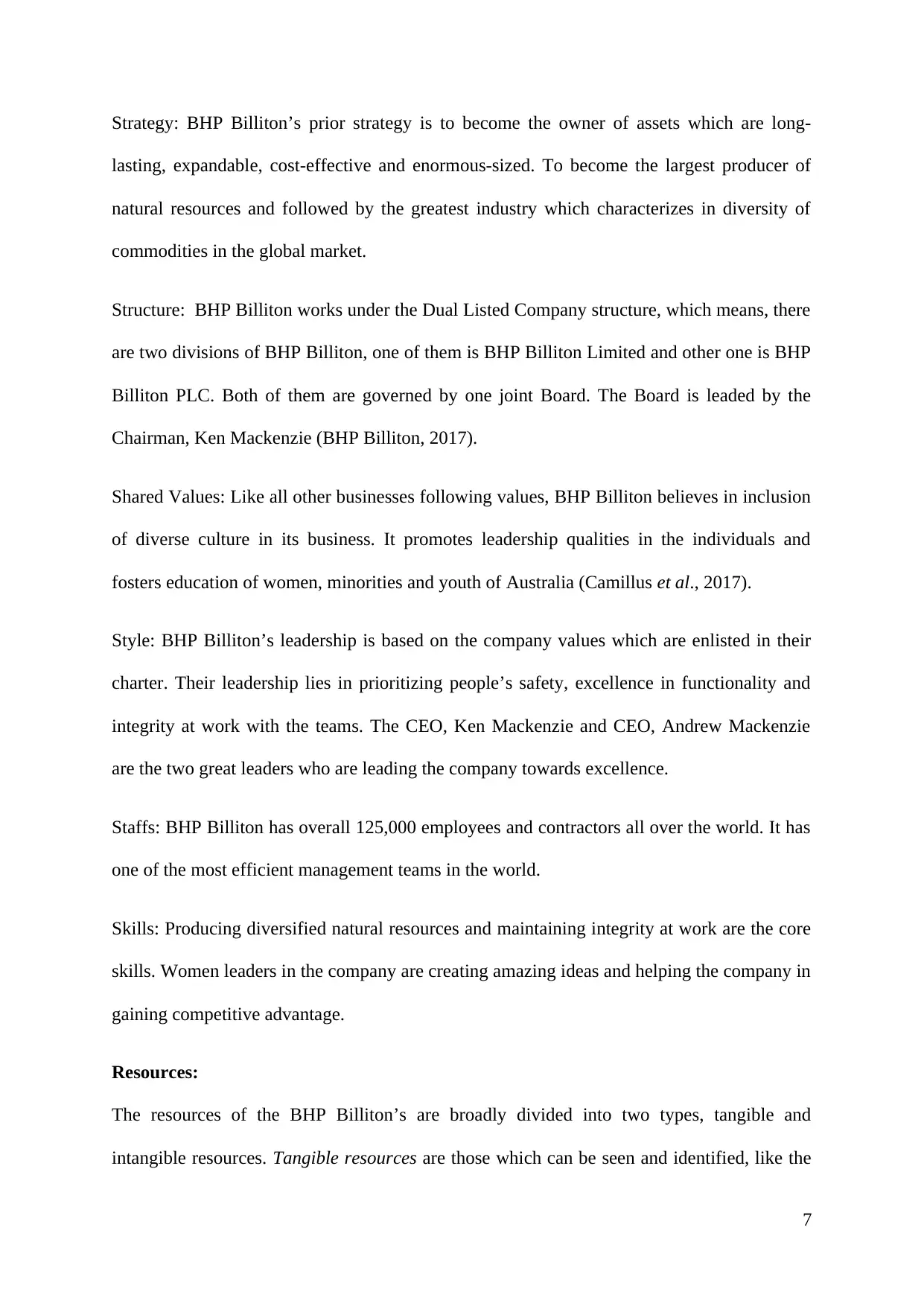
Strategy: BHP Billiton’s prior strategy is to become the owner of assets which are long-
lasting, expandable, cost-effective and enormous-sized. To become the largest producer of
natural resources and followed by the greatest industry which characterizes in diversity of
commodities in the global market.
Structure: BHP Billiton works under the Dual Listed Company structure, which means, there
are two divisions of BHP Billiton, one of them is BHP Billiton Limited and other one is BHP
Billiton PLC. Both of them are governed by one joint Board. The Board is leaded by the
Chairman, Ken Mackenzie (BHP Billiton, 2017).
Shared Values: Like all other businesses following values, BHP Billiton believes in inclusion
of diverse culture in its business. It promotes leadership qualities in the individuals and
fosters education of women, minorities and youth of Australia (Camillus et al., 2017).
Style: BHP Billiton’s leadership is based on the company values which are enlisted in their
charter. Their leadership lies in prioritizing people’s safety, excellence in functionality and
integrity at work with the teams. The CEO, Ken Mackenzie and CEO, Andrew Mackenzie
are the two great leaders who are leading the company towards excellence.
Staffs: BHP Billiton has overall 125,000 employees and contractors all over the world. It has
one of the most efficient management teams in the world.
Skills: Producing diversified natural resources and maintaining integrity at work are the core
skills. Women leaders in the company are creating amazing ideas and helping the company in
gaining competitive advantage.
Resources:
The resources of the BHP Billiton’s are broadly divided into two types, tangible and
intangible resources. Tangible resources are those which can be seen and identified, like the
7
lasting, expandable, cost-effective and enormous-sized. To become the largest producer of
natural resources and followed by the greatest industry which characterizes in diversity of
commodities in the global market.
Structure: BHP Billiton works under the Dual Listed Company structure, which means, there
are two divisions of BHP Billiton, one of them is BHP Billiton Limited and other one is BHP
Billiton PLC. Both of them are governed by one joint Board. The Board is leaded by the
Chairman, Ken Mackenzie (BHP Billiton, 2017).
Shared Values: Like all other businesses following values, BHP Billiton believes in inclusion
of diverse culture in its business. It promotes leadership qualities in the individuals and
fosters education of women, minorities and youth of Australia (Camillus et al., 2017).
Style: BHP Billiton’s leadership is based on the company values which are enlisted in their
charter. Their leadership lies in prioritizing people’s safety, excellence in functionality and
integrity at work with the teams. The CEO, Ken Mackenzie and CEO, Andrew Mackenzie
are the two great leaders who are leading the company towards excellence.
Staffs: BHP Billiton has overall 125,000 employees and contractors all over the world. It has
one of the most efficient management teams in the world.
Skills: Producing diversified natural resources and maintaining integrity at work are the core
skills. Women leaders in the company are creating amazing ideas and helping the company in
gaining competitive advantage.
Resources:
The resources of the BHP Billiton’s are broadly divided into two types, tangible and
intangible resources. Tangible resources are those which can be seen and identified, like the
7
Paraphrase This Document
Need a fresh take? Get an instant paraphrase of this document with our AI Paraphraser
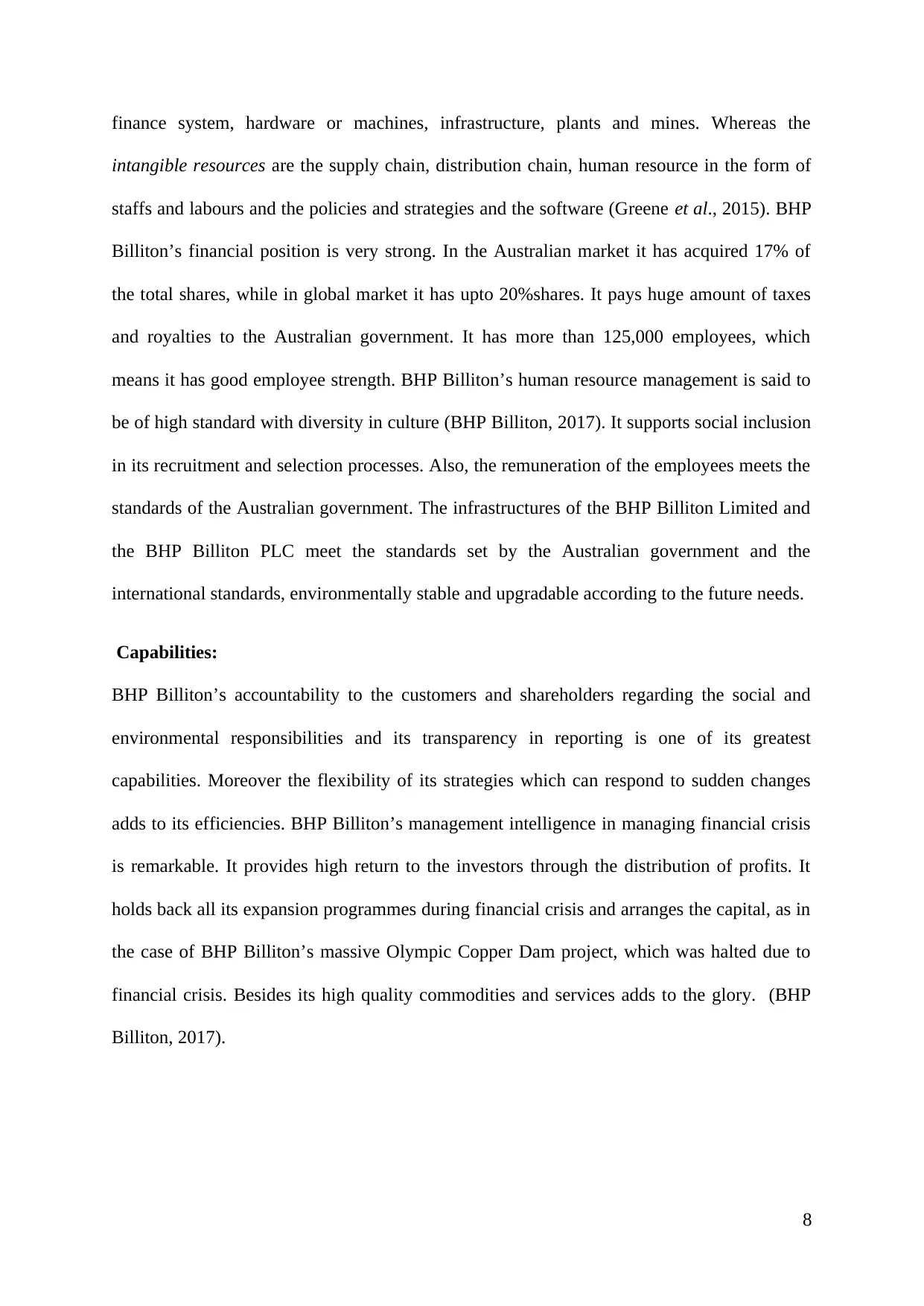
finance system, hardware or machines, infrastructure, plants and mines. Whereas the
intangible resources are the supply chain, distribution chain, human resource in the form of
staffs and labours and the policies and strategies and the software (Greene et al., 2015). BHP
Billiton’s financial position is very strong. In the Australian market it has acquired 17% of
the total shares, while in global market it has upto 20%shares. It pays huge amount of taxes
and royalties to the Australian government. It has more than 125,000 employees, which
means it has good employee strength. BHP Billiton’s human resource management is said to
be of high standard with diversity in culture (BHP Billiton, 2017). It supports social inclusion
in its recruitment and selection processes. Also, the remuneration of the employees meets the
standards of the Australian government. The infrastructures of the BHP Billiton Limited and
the BHP Billiton PLC meet the standards set by the Australian government and the
international standards, environmentally stable and upgradable according to the future needs.
Capabilities:
BHP Billiton’s accountability to the customers and shareholders regarding the social and
environmental responsibilities and its transparency in reporting is one of its greatest
capabilities. Moreover the flexibility of its strategies which can respond to sudden changes
adds to its efficiencies. BHP Billiton’s management intelligence in managing financial crisis
is remarkable. It provides high return to the investors through the distribution of profits. It
holds back all its expansion programmes during financial crisis and arranges the capital, as in
the case of BHP Billiton’s massive Olympic Copper Dam project, which was halted due to
financial crisis. Besides its high quality commodities and services adds to the glory. (BHP
Billiton, 2017).
8
intangible resources are the supply chain, distribution chain, human resource in the form of
staffs and labours and the policies and strategies and the software (Greene et al., 2015). BHP
Billiton’s financial position is very strong. In the Australian market it has acquired 17% of
the total shares, while in global market it has upto 20%shares. It pays huge amount of taxes
and royalties to the Australian government. It has more than 125,000 employees, which
means it has good employee strength. BHP Billiton’s human resource management is said to
be of high standard with diversity in culture (BHP Billiton, 2017). It supports social inclusion
in its recruitment and selection processes. Also, the remuneration of the employees meets the
standards of the Australian government. The infrastructures of the BHP Billiton Limited and
the BHP Billiton PLC meet the standards set by the Australian government and the
international standards, environmentally stable and upgradable according to the future needs.
Capabilities:
BHP Billiton’s accountability to the customers and shareholders regarding the social and
environmental responsibilities and its transparency in reporting is one of its greatest
capabilities. Moreover the flexibility of its strategies which can respond to sudden changes
adds to its efficiencies. BHP Billiton’s management intelligence in managing financial crisis
is remarkable. It provides high return to the investors through the distribution of profits. It
holds back all its expansion programmes during financial crisis and arranges the capital, as in
the case of BHP Billiton’s massive Olympic Copper Dam project, which was halted due to
financial crisis. Besides its high quality commodities and services adds to the glory. (BHP
Billiton, 2017).
8
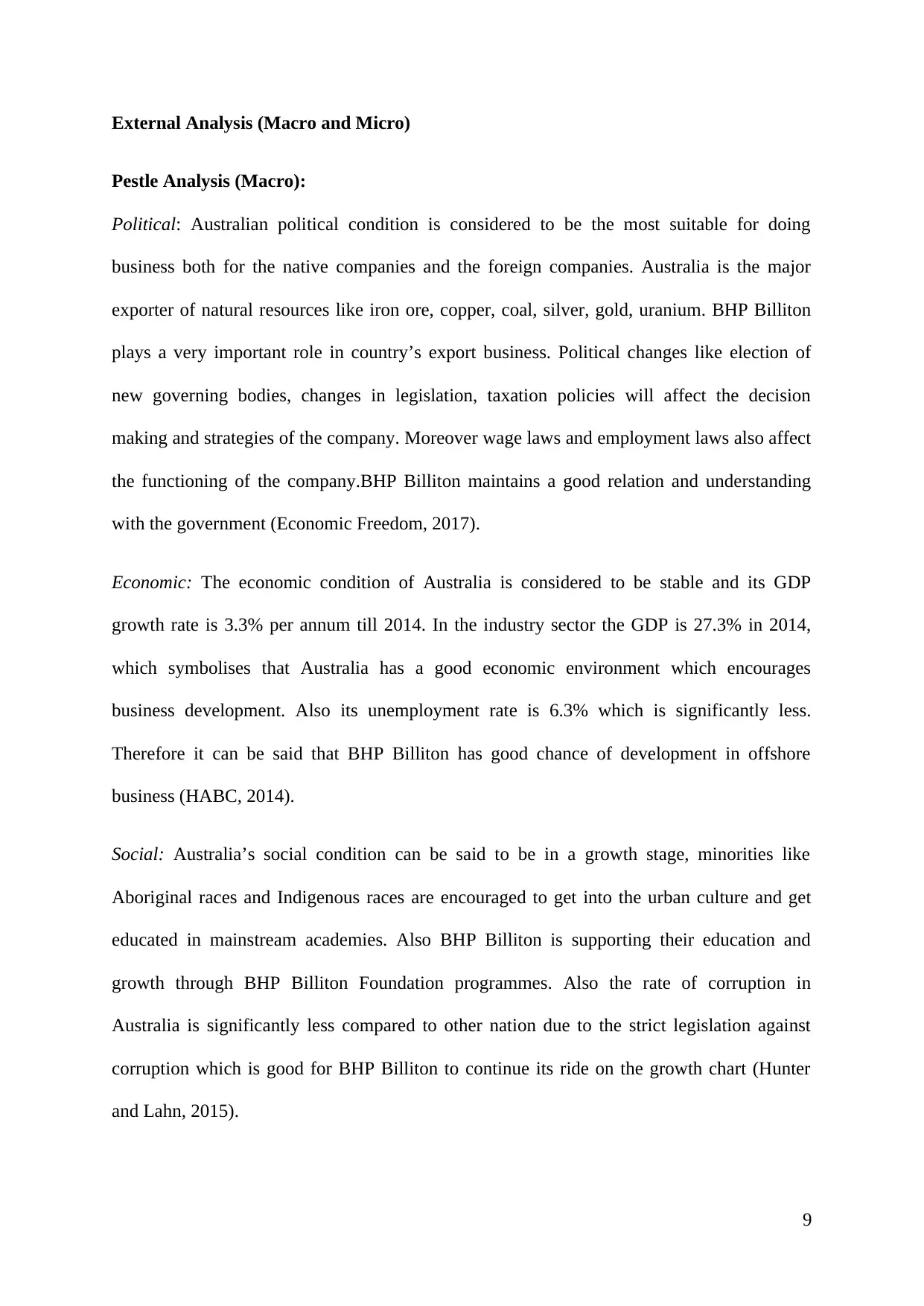
External Analysis (Macro and Micro)
Pestle Analysis (Macro):
Political: Australian political condition is considered to be the most suitable for doing
business both for the native companies and the foreign companies. Australia is the major
exporter of natural resources like iron ore, copper, coal, silver, gold, uranium. BHP Billiton
plays a very important role in country’s export business. Political changes like election of
new governing bodies, changes in legislation, taxation policies will affect the decision
making and strategies of the company. Moreover wage laws and employment laws also affect
the functioning of the company.BHP Billiton maintains a good relation and understanding
with the government (Economic Freedom, 2017).
Economic: The economic condition of Australia is considered to be stable and its GDP
growth rate is 3.3% per annum till 2014. In the industry sector the GDP is 27.3% in 2014,
which symbolises that Australia has a good economic environment which encourages
business development. Also its unemployment rate is 6.3% which is significantly less.
Therefore it can be said that BHP Billiton has good chance of development in offshore
business (HABC, 2014).
Social: Australia’s social condition can be said to be in a growth stage, minorities like
Aboriginal races and Indigenous races are encouraged to get into the urban culture and get
educated in mainstream academies. Also BHP Billiton is supporting their education and
growth through BHP Billiton Foundation programmes. Also the rate of corruption in
Australia is significantly less compared to other nation due to the strict legislation against
corruption which is good for BHP Billiton to continue its ride on the growth chart (Hunter
and Lahn, 2015).
9
Pestle Analysis (Macro):
Political: Australian political condition is considered to be the most suitable for doing
business both for the native companies and the foreign companies. Australia is the major
exporter of natural resources like iron ore, copper, coal, silver, gold, uranium. BHP Billiton
plays a very important role in country’s export business. Political changes like election of
new governing bodies, changes in legislation, taxation policies will affect the decision
making and strategies of the company. Moreover wage laws and employment laws also affect
the functioning of the company.BHP Billiton maintains a good relation and understanding
with the government (Economic Freedom, 2017).
Economic: The economic condition of Australia is considered to be stable and its GDP
growth rate is 3.3% per annum till 2014. In the industry sector the GDP is 27.3% in 2014,
which symbolises that Australia has a good economic environment which encourages
business development. Also its unemployment rate is 6.3% which is significantly less.
Therefore it can be said that BHP Billiton has good chance of development in offshore
business (HABC, 2014).
Social: Australia’s social condition can be said to be in a growth stage, minorities like
Aboriginal races and Indigenous races are encouraged to get into the urban culture and get
educated in mainstream academies. Also BHP Billiton is supporting their education and
growth through BHP Billiton Foundation programmes. Also the rate of corruption in
Australia is significantly less compared to other nation due to the strict legislation against
corruption which is good for BHP Billiton to continue its ride on the growth chart (Hunter
and Lahn, 2015).
9
⊘ This is a preview!⊘
Do you want full access?
Subscribe today to unlock all pages.

Trusted by 1+ million students worldwide
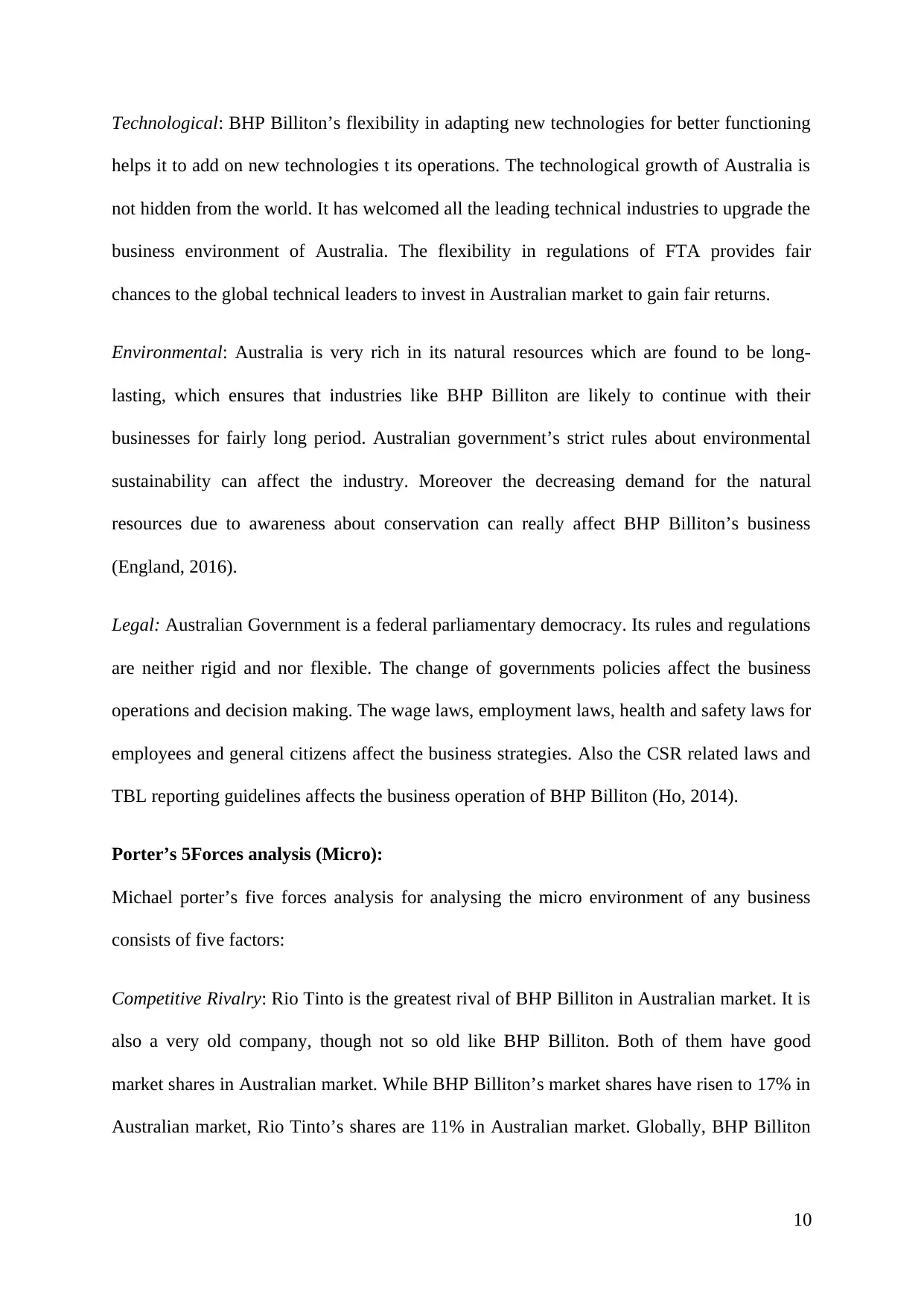
Technological: BHP Billiton’s flexibility in adapting new technologies for better functioning
helps it to add on new technologies t its operations. The technological growth of Australia is
not hidden from the world. It has welcomed all the leading technical industries to upgrade the
business environment of Australia. The flexibility in regulations of FTA provides fair
chances to the global technical leaders to invest in Australian market to gain fair returns.
Environmental: Australia is very rich in its natural resources which are found to be long-
lasting, which ensures that industries like BHP Billiton are likely to continue with their
businesses for fairly long period. Australian government’s strict rules about environmental
sustainability can affect the industry. Moreover the decreasing demand for the natural
resources due to awareness about conservation can really affect BHP Billiton’s business
(England, 2016).
Legal: Australian Government is a federal parliamentary democracy. Its rules and regulations
are neither rigid and nor flexible. The change of governments policies affect the business
operations and decision making. The wage laws, employment laws, health and safety laws for
employees and general citizens affect the business strategies. Also the CSR related laws and
TBL reporting guidelines affects the business operation of BHP Billiton (Ho, 2014).
Porter’s 5Forces analysis (Micro):
Michael porter’s five forces analysis for analysing the micro environment of any business
consists of five factors:
Competitive Rivalry: Rio Tinto is the greatest rival of BHP Billiton in Australian market. It is
also a very old company, though not so old like BHP Billiton. Both of them have good
market shares in Australian market. While BHP Billiton’s market shares have risen to 17% in
Australian market, Rio Tinto’s shares are 11% in Australian market. Globally, BHP Billiton
10
helps it to add on new technologies t its operations. The technological growth of Australia is
not hidden from the world. It has welcomed all the leading technical industries to upgrade the
business environment of Australia. The flexibility in regulations of FTA provides fair
chances to the global technical leaders to invest in Australian market to gain fair returns.
Environmental: Australia is very rich in its natural resources which are found to be long-
lasting, which ensures that industries like BHP Billiton are likely to continue with their
businesses for fairly long period. Australian government’s strict rules about environmental
sustainability can affect the industry. Moreover the decreasing demand for the natural
resources due to awareness about conservation can really affect BHP Billiton’s business
(England, 2016).
Legal: Australian Government is a federal parliamentary democracy. Its rules and regulations
are neither rigid and nor flexible. The change of governments policies affect the business
operations and decision making. The wage laws, employment laws, health and safety laws for
employees and general citizens affect the business strategies. Also the CSR related laws and
TBL reporting guidelines affects the business operation of BHP Billiton (Ho, 2014).
Porter’s 5Forces analysis (Micro):
Michael porter’s five forces analysis for analysing the micro environment of any business
consists of five factors:
Competitive Rivalry: Rio Tinto is the greatest rival of BHP Billiton in Australian market. It is
also a very old company, though not so old like BHP Billiton. Both of them have good
market shares in Australian market. While BHP Billiton’s market shares have risen to 17% in
Australian market, Rio Tinto’s shares are 11% in Australian market. Globally, BHP Billiton
10
Paraphrase This Document
Need a fresh take? Get an instant paraphrase of this document with our AI Paraphraser
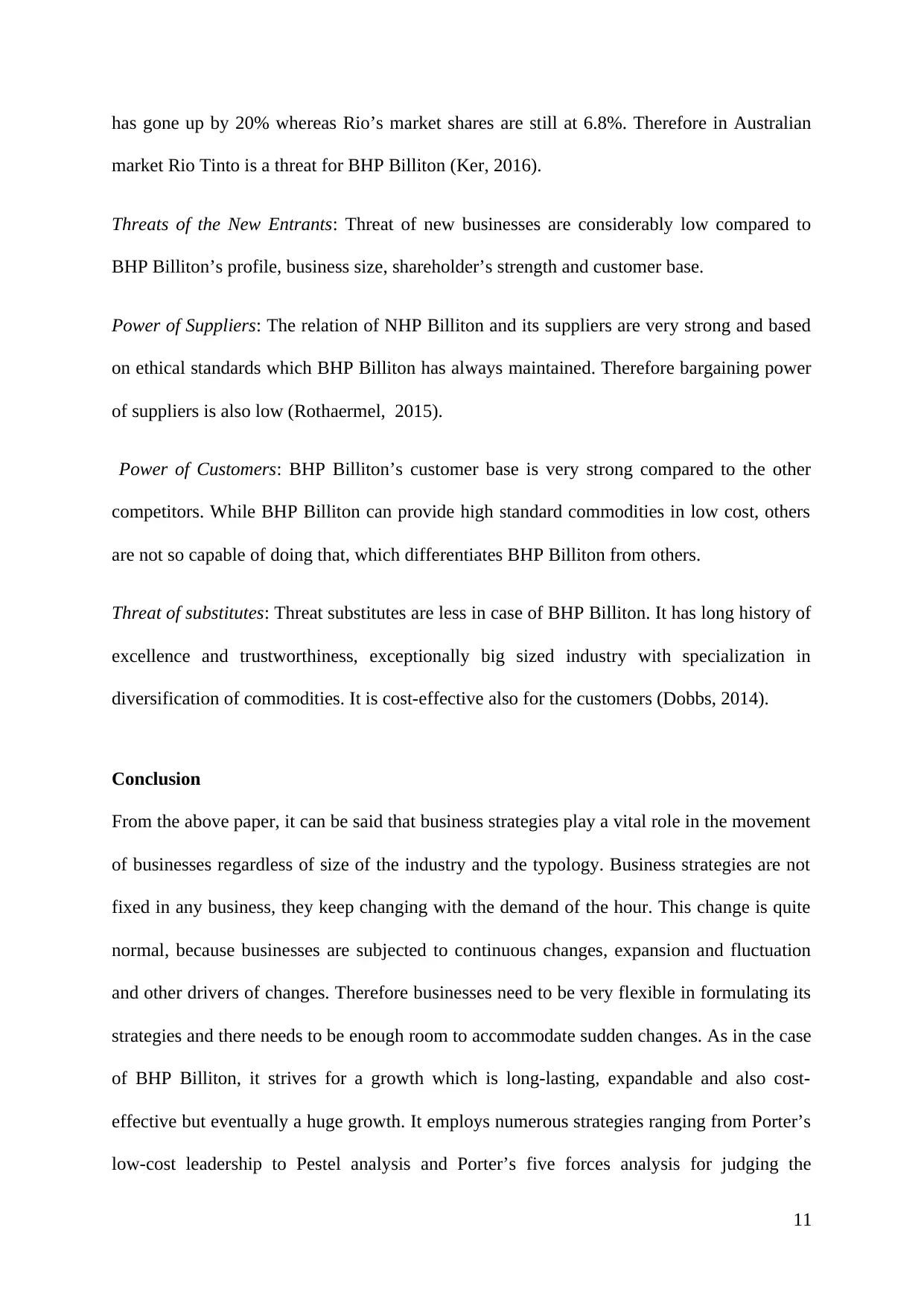
has gone up by 20% whereas Rio’s market shares are still at 6.8%. Therefore in Australian
market Rio Tinto is a threat for BHP Billiton (Ker, 2016).
Threats of the New Entrants: Threat of new businesses are considerably low compared to
BHP Billiton’s profile, business size, shareholder’s strength and customer base.
Power of Suppliers: The relation of NHP Billiton and its suppliers are very strong and based
on ethical standards which BHP Billiton has always maintained. Therefore bargaining power
of suppliers is also low (Rothaermel, 2015).
Power of Customers: BHP Billiton’s customer base is very strong compared to the other
competitors. While BHP Billiton can provide high standard commodities in low cost, others
are not so capable of doing that, which differentiates BHP Billiton from others.
Threat of substitutes: Threat substitutes are less in case of BHP Billiton. It has long history of
excellence and trustworthiness, exceptionally big sized industry with specialization in
diversification of commodities. It is cost-effective also for the customers (Dobbs, 2014).
Conclusion
From the above paper, it can be said that business strategies play a vital role in the movement
of businesses regardless of size of the industry and the typology. Business strategies are not
fixed in any business, they keep changing with the demand of the hour. This change is quite
normal, because businesses are subjected to continuous changes, expansion and fluctuation
and other drivers of changes. Therefore businesses need to be very flexible in formulating its
strategies and there needs to be enough room to accommodate sudden changes. As in the case
of BHP Billiton, it strives for a growth which is long-lasting, expandable and also cost-
effective but eventually a huge growth. It employs numerous strategies ranging from Porter’s
low-cost leadership to Pestel analysis and Porter’s five forces analysis for judging the
11
market Rio Tinto is a threat for BHP Billiton (Ker, 2016).
Threats of the New Entrants: Threat of new businesses are considerably low compared to
BHP Billiton’s profile, business size, shareholder’s strength and customer base.
Power of Suppliers: The relation of NHP Billiton and its suppliers are very strong and based
on ethical standards which BHP Billiton has always maintained. Therefore bargaining power
of suppliers is also low (Rothaermel, 2015).
Power of Customers: BHP Billiton’s customer base is very strong compared to the other
competitors. While BHP Billiton can provide high standard commodities in low cost, others
are not so capable of doing that, which differentiates BHP Billiton from others.
Threat of substitutes: Threat substitutes are less in case of BHP Billiton. It has long history of
excellence and trustworthiness, exceptionally big sized industry with specialization in
diversification of commodities. It is cost-effective also for the customers (Dobbs, 2014).
Conclusion
From the above paper, it can be said that business strategies play a vital role in the movement
of businesses regardless of size of the industry and the typology. Business strategies are not
fixed in any business, they keep changing with the demand of the hour. This change is quite
normal, because businesses are subjected to continuous changes, expansion and fluctuation
and other drivers of changes. Therefore businesses need to be very flexible in formulating its
strategies and there needs to be enough room to accommodate sudden changes. As in the case
of BHP Billiton, it strives for a growth which is long-lasting, expandable and also cost-
effective but eventually a huge growth. It employs numerous strategies ranging from Porter’s
low-cost leadership to Pestel analysis and Porter’s five forces analysis for judging the
11

external environment and McKinsey’s 7S framework for internal analysis, which has been
presented in the paper.
12
presented in the paper.
12
⊘ This is a preview!⊘
Do you want full access?
Subscribe today to unlock all pages.

Trusted by 1+ million students worldwide
1 out of 14
Related Documents
Your All-in-One AI-Powered Toolkit for Academic Success.
+13062052269
info@desklib.com
Available 24*7 on WhatsApp / Email
![[object Object]](/_next/static/media/star-bottom.7253800d.svg)
Unlock your academic potential
Copyright © 2020–2025 A2Z Services. All Rights Reserved. Developed and managed by ZUCOL.





